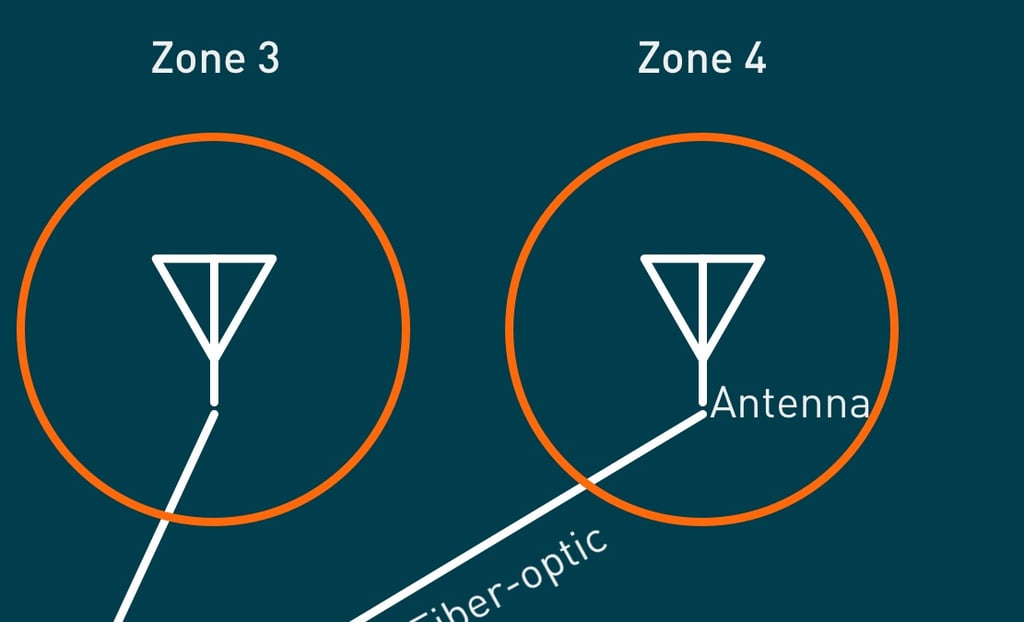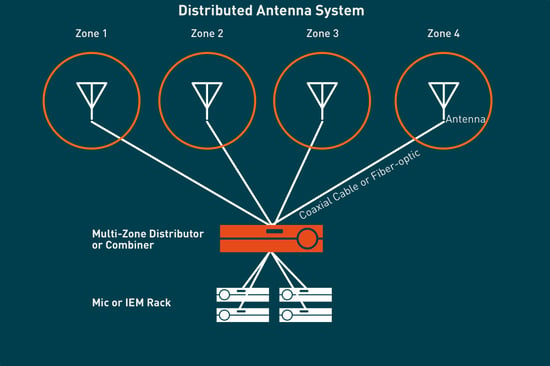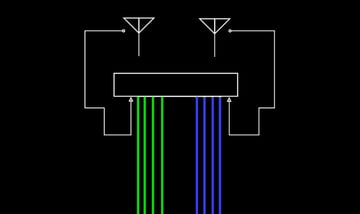
We posted an article comparing antenna distributors and combiners many months ago. It was a successful piece, but it never addressed the more fundamental question, what is antenna distribution? I’m glad you ask.
Antenna distribution refers to the numerous methods of distributing radio signals through one or many antennas. Technically, "antenna distribution" might be the wrong terminology, even though it is used across the A/V industry.
In wireless audio, antenna distribution is most commonly used to route multiple signals through a single antenna (which is, technically, referred to as "multi-coupling"), either transmitted signals or received signals. Less commonly, large facilities will contain “distributed antenna systems,” where multiple signals are sent through multiple antennas separated in physical space.
 Diagram of a distributed antenna system.
Diagram of a distributed antenna system.
The former is used to take multiple signals arriving at a single location (like a paddle antenna) and guide them to their respective receivers, or to take multiple transmitted signals and project them through a single antenna in an advantageous location (like a paddle antenna used for IEMs). The latter usually sends multiple signals out to multiple antennas from a central control room, or allows a central control room to monitor multiple signals arriving from multiple remote antennas spread out across multiple rooms. Our partners at Professional Wireless Services are experts in designing distributed antenna systems.
Antenna distribution leverages the ability of one antenna to receive or transmit as many frequencies as you can push into it. That is, each device does not need to have its own antenna. Through cabling, splitting, and amplification, many signals can share the same antenna. Or, think of it this way: if one antenna functions well to pick up a single transmitter on multiple frequencies (what we call a broadband antenna) it also is able to collect or push out multiple signals on multiple frequencies.
There are two antenna distribution devices common to wireless audio. The antenna distributor receives multiple microphone signals through a pair of antennas, splits and amplify those signals, and sends each to their respective receiver via coaxial cable. The transmitter combiner pushes multiple IEM transmitter signals through a single antenna.
Antenna distribution benefits you, the user, in many ways.
- More organized, manageable cabling.
- Flexibility in antenna choice - any external antenna can be mounted to an antenna distributor or combiner.
- Flexibility in antenna placement - the antenna can be remoted anywhere, so you don’t need to keep your antennas near the rack.
- No more antenna farming, which reduces the likelihood of IMD (essential when using multiple IEMs).
- DC power outputs are supplied on some distributors, so you can say goodbye to mountains of wall warts on a power strip.
- Possibly lower cost, if your other plan is to purchase multiple separate paddle antennas for all of your receivers.
Finally, antenna distributors can not be used as transmitter combiners, and vice versa.
Alex Milne
Alex Milne was Product Marketing Manager and Digital Marketing Manager for RF Venue, and a writer for the RF Venue Blog, from 2014-2017. He is founder and CEO of Terraband, Inc., a networking and ICT infrastructure company based in Brooklyn, NY., and blogs on spectrum management, and other topics where technology,...
More from the blog

Correct Antenna Distribution in Three Simple Diagrams

Wireless Microphone Distribution Explained

Three Passive Splitter Hacks for Antenna Distribution
Subscribe to email updates
Stay up-to-date on what's happening at this blog and get additional content about the benefits of subscribing.


